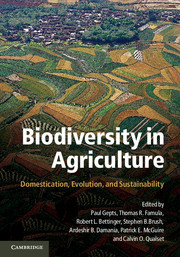Book contents
- Frontmatter
- Contents
- Tables
- Figures
- Foreword
- Contributors
- Acknowledgments
- Introduction: The Domestication of Plants and Animals: Ten Unanswered Questions
- 1 The Local Origins of Domestication
- Section I Early Steps in Agricultural Domestication
- Section II Domestication of Animals and Impacts on Humans
- Section III Issues in Plant Domestication
- Section IV Traditional Management of Biodiversity
- Section V Uses of Biodiversity and New and Future Domestications
- 22 Participatory Domestication of Indigenous Fruit and Nut Trees: New Crops for Sustainable Agriculture in Developing Countries
- 23 The Introduction and Dispersal of Vitis vinifera into California: A Case Study of the Interaction of People, Plants, Economics, and Environment
- 24 Genetic Resources of Yeast and Other Micro-Organisms
- 25 Biodiversity of Native Bees and Crop Pollination with Emphasis on California
- 26 Aquaculture, the Next Wave of Domestication
- 27 Genetic Sustainability and Biodiversity: Challenges to the California Dairy Industry
- Index
- References
24 - Genetic Resources of Yeast and Other Micro-Organisms
Published online by Cambridge University Press: 05 June 2012
- Frontmatter
- Contents
- Tables
- Figures
- Foreword
- Contributors
- Acknowledgments
- Introduction: The Domestication of Plants and Animals: Ten Unanswered Questions
- 1 The Local Origins of Domestication
- Section I Early Steps in Agricultural Domestication
- Section II Domestication of Animals and Impacts on Humans
- Section III Issues in Plant Domestication
- Section IV Traditional Management of Biodiversity
- Section V Uses of Biodiversity and New and Future Domestications
- 22 Participatory Domestication of Indigenous Fruit and Nut Trees: New Crops for Sustainable Agriculture in Developing Countries
- 23 The Introduction and Dispersal of Vitis vinifera into California: A Case Study of the Interaction of People, Plants, Economics, and Environment
- 24 Genetic Resources of Yeast and Other Micro-Organisms
- 25 Biodiversity of Native Bees and Crop Pollination with Emphasis on California
- 26 Aquaculture, the Next Wave of Domestication
- 27 Genetic Sustainability and Biodiversity: Challenges to the California Dairy Industry
- Index
- References
Summary
Micro-organisms have been employed in the production of foodstuffs for millennia, but only knowingly so since the work of scientists such as Charles Cagniard-Latour, Theodor Schwann, Friedrich Kutzing, and Louis Pasteur (Anderson 1995, Barnett 2003). As recently as 1839, the likes of Liebig and Wohler were ridiculing the concept that alcoholic fermentation was anything other than a basic piece of chemistry (Anonymous 1839). And yet for the longest time, processes such as beer fermentation employed “back slopping” in which a proportion of a successful brew was added back to a new brew to “kick-start” it. They were unwittingly priming with the yeast that had multiplied in the previous batch – and they pronounced that this barm from the foamy heads of the vessel signified godesgoode “bicause it cometh of the grete grace of God” (David 2001).
Legras et al. (2007) argue for diversity in Saccharomyces founded upon human history. They draw attention to genetic relatedness between strains, with bread yeasts displaying a genetic make-up intermediate between beer and wine strains, with the strains used for the production of rice wine and sake being closely related to beer and bread strains. However they emphasize that local domestication makes a sizeable contribution to the genetic diversity. In the case of wine yeasts, for instance, they propose that the organism followed the migration of humans and their vines.
- Type
- Chapter
- Information
- Biodiversity in AgricultureDomestication, Evolution, and Sustainability, pp. 515 - 525Publisher: Cambridge University PressPrint publication year: 2012



